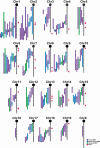Mouse BMD quantitative trait loci show improved concordance with human genome-wide association loci when recalculated on a new, common mouse genetic map
- PMID: 20200990
- PMCID: PMC3153351
- DOI: 10.1002/jbmr.72
Mouse BMD quantitative trait loci show improved concordance with human genome-wide association loci when recalculated on a new, common mouse genetic map
Abstract
Bone mineral density (BMD) is a heritable trait, and in mice, over 100 quantitative trait loci (QTLs) have been reported, but candidate genes have been identified for only a small percentage. Persistent errors in the mouse genetic map have negatively affected QTL localization, spurring the development of a new, corrected map. In this study, QTLs for BMD were remapped in 11 archival mouse data sets using this new genetic map. Since these QTLs all were mapped in a comparable way, direct comparisons of QTLs for concordance would be valid. We then compared human genome-wide association study (GWAS) BMD loci with the mouse QTLs. We found that 26 of the 28 human GWAS loci examined were located within the confidence interval of a mouse QTL. Furthermore, 14 of the GWAS loci mapped to within 3 cM of a mouse QTL peak. Lastly, we demonstrated that these newly remapped mouse QTLs can substantiate a candidate gene for a human GWAS locus, for which the peak single-nucleotide polymorphism (SNP) fell in an intergenic region. Specifically, we suggest that MEF2C (human chromosome 5, mouse chromosome 13) should be considered a candidate gene for the genetic regulation of BMD. In conclusion, use of the new mouse genetic map has improved the localization of mouse BMD QTLs, and these remapped QTLs show high concordance with human GWAS loci. We believe that this is an opportune time for a renewed effort by the genetics community to identify the causal variants regulating BMD using a synergistic mouse-human approach.
Figures


References
-
- US Department of Health and Human Services. Bone Health and Osteoporosis: A Report of the Surgeon General. 2004. Rockville, MD: US Department of Health and Human Services, Office of the Surgeon General.
-
- Ralston S, de Crombrugghe B. Genetic regulation of bone mass and susceptibility to osteoporosis. Genes Dev. 2006;20:2492–2506. - PubMed
-
- Ferrari S. Human genetics of osteoporosis. Best Pract Res Clin Endocrinol Metab. 2008;22:723–735. - PubMed
Publication types
MeSH terms
Substances
Grants and funding
LinkOut - more resources
Full Text Sources
Medical
Molecular Biology Databases

